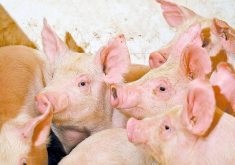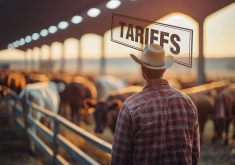Overfeed There is always a tendency to overfeed the better — and more expensive — diets
In my last article, I talked about the importance of stimulating feed intake very soon after weaning in order to get nursery pigs off to a good start. This has implications for growth performance, but it also impacts health, especially gut health. The pig faces two digestive challenges at this time. First, the change of diet from milk, which requires gut enzymes to digest lactose and fat, to a dry starter diet which requires different enzymes for digestion. Second, its maternal immunity has declined considerably, reducing its resistance to disease.
Read Also

Horns aren’t unlocking anytime soon on livestock transport standards
Standards good enough meet the definition of “humane” animal transportation still vary widely between what what industry wants, what animal rights advocates want and, between the two, what federal regulators decide is good enough.
Low feed intake after weaning results in an increase in gut pH and pathogenic E. coli bacteria proliferate in the small intestine. These bacteria attach themselves to the villi — the minute finger-like projections in the gut which absorb nutrients — and produce toxins which erode the villi and surface of the gut. Once the gut is damaged in this way its absorptive capacity is greatly reduced, resulting in poor growth or diarrhea.
Modern pre-starter diets attempt to overcome this problem by including processed cereals, milk products such as lactose, and animal proteins, making the diet highly digestible and very palatable. Assuming the pig adapts to solid feed quickly, which stimulates production of hydrochloric acid in its stomach, gut pH is maintained and harmful bacteria kept at bay.
These complex pre-starter diets are very expensive and cannot be fed for long. Also, the pig’s enzyme system develops rapidly after weaning, making it increasingly capable of digesting unprocessed cereals and conventional protein sources such as soybean meal.
Therefore nutritionists design a series of diets — typically about four depending on exit weight — with increasing amounts of “conventional” raw materials and decreasing cost. In order to ensure the diets are fed over the correct weight ranges, the nutritionist will also develop a feed budget that can be applied on the farm. The objective of this is to define the amount of each diet fed according to weight and to help ensure that expensive diets are not overused. It will make assumptions about growth rate and feed efficiency over each stage.
In order to get any value out of this, actual feed consumption of each diet for every nursery batch must be measured and recorded. This allows deviations from budget to be identified and adjusted. If entry and exit weights are available, growth rate can be calculated. Diet costs are also a key part of the feed budget and must be updated regularly so that overall nursery feed cost can be monitored.
There is always a tendency to overfeed the better — and more expensive — diets. Implementing a good feed budget program can not only identify where this is taking place, but illustrate the cost implications. After all, an extra kilo of a $1,000/tonne starter diet increases cost per pig by $1 and may be an unnecessary waste. Not only that, but applying the feed budget correctly according to weight will result in the highest performance.
Unfortunately, it’s not quite that simple. Notice that I have referred to applying the budget according to weight, not age. That’s where the difficulty creeps in. As individual weaning weights vary considerably, so does the development of the pigs’ digestive enzyme systems and their ability to cope with “simpler” diets. Therefore, to get the best out of the feed budgeting process, it is necessary to feed according to the pigs’ weight category and define intake of each diet accordingly. This is done through a feed allocation program (Table 1).In this example, the amount of pre-starter fed is dependent upon the weight at weaning and then Starter 1 and Starter 2 diets are fed strictly according to the budgeted amount. Starter 3 is fed until the pigs are transferred to finishing. The performance figures are an estimate calculated from expected weight at transfer and FCE.
Varying the amount of pre-starter diet fed according to weight allows the smaller pigs to receive the better diet for longer, giving their digestive system more time to adjust. It also helps to improve their feed intake and get them off to a faster start than they would if fed according to age. While the management of both the feed budget and feed allocation program takes time and effort, it will help to maximize the growth of all pigs in the nursery. And, with feed costs at an historic high, effective feed budgeting has the potential to shave a worthwhile amount off total feed cost per pig.
table 1 example of feed allocation program
- Category of pig V small Small Medium Large
- % of pigs 2.5% 12.5% 70% 15%
- Av. wean wt. – kg 3.86 4.66 5.49 6.52
- Diet Budget Amount fed per pig (kg)
- amount/pig (kg)
- Pre-starter 1.00 3.00 1.75 0.90 0.51
- Starter 1 2.00 2.00 2.00 2.00 2.00
- Starter 2 5.75 5.75 5.75 5.75 5.75
- Starter 3 20.45 14.23 17.70 20.66 22.60
- Expected performance
- Weight out (kg) 25.00 20.00 22.57 25.05 27.51
- Total feed/pig (kg) 29.20 24.98 27.20 29.31 30.86
- Gain/pig (kg) 19.50 16.14 17.91 18.56 20.99
- FCE 1.50 1.55 1.52 1.50 1.47














